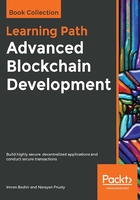
上QQ阅读APP看书,第一时间看更新
How blockchain accumulates blocks
Now we will look at a general scheme for creating blocks. This scheme is presented here to give you a general idea of how blocks are generated and what the relationship is between transactions and blocks:
- A node starts a transaction by first creating and then digitally signing it with its private key. A transaction can represent various actions in a blockchain. Most commonly this is a data structure that represents transfer of value between users on the blockchain network. Transaction data structure usually consists of some logic of transfer of value, relevant rules, source and destination addresses, and other validation information. This will be covered in more detail in specific chapters on Bitcoin and Ethereum later in the book.
- A transaction is propagated (flooded) by using a flooding protocol, called Gossip protocol, to peers that validate the transaction based on preset criteria. Usually, more than one node are required to verify the transaction.
- Once the transaction is validated, it is included in a block, which is then propagated onto the network. At this point, the transaction is considered confirmed.
- The newly-created block now becomes part of the ledger, and the next block links itself cryptographically back to this block. This link is a hash pointer. At this stage, the transaction gets its second confirmation and the block gets its first confirmation.
- Transactions are then reconfirmed every time a new block is created. Usually, six confirmations in the Bitcoin network are required to consider the transaction final.
It is worth noting that steps 4 and 5 are considered non-compulsory, as the transaction itself is finalized in step 3; however, block confirmation and further transaction reconfirmations, if required, are then carried out in step 4 and step 5.
This completes the basic introduction to blockchain. In the next section, you will learn about the benefits and limitations of this technology.